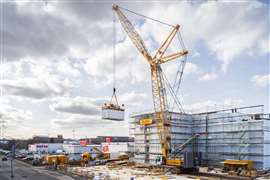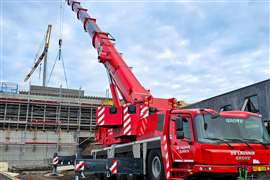expert viewpoint: on daily pre-operational crane inspections
24 April 2008

A daily pre-operational inspection of a mobile crane is as important as knowing the weight of the load, the correct radius of the lift, and the net lift capacity of crane. Thorough pre-operational inspections are a vital part of a comprehensive crane management and safety program.
Mobile crane pre-operational inspections confirm that the machine is safe to operate and is in serviceable condition for the day's work. Crane inspections involve certain items that are required by federal regulations and other items that are recommended by industry safety standards, known as “best practices.” The frequent inspection has the recommendation required by federal regulations and it is a best practice that daily inspection records be retained in the crane's history file.
Two OSHA regulations address mobile crane inspections: 29 CFR 1926.550 (OSHA) and 29 CFR 1910.180 (OSHA). The first regulation, 29 CFR 1926.550 states, in part, “The employer shall designate a competent person who shall inspect all machinery and equipment prior to each use, and during use, to make sure it is in safe operating condition. Any deficiencies shall be repaired, or defective parts replaced before continued use.” In addition, 29 CFR 1910.180 specifies two types of inspections - frequent and periodic. Frequent inspections are to be conducted on a daily to monthly basis. Periodic inspections are those that are to be performed on a monthly to annual basis.
When a designated, competent person is conducting the pre-operational inspection, the first thing to be determined should be, “Is this crane safe to use today?” Even though the machine may have had a thorough annual inspection performed the previous day, the possibility exists that something may have been broken, or that the crane was operated in an unsafe manner since the last inspection. Daily inspections should be conducted using a checklist, although written documentation is not required. However, all branches of the armed forces, government agencies, and a majority of crane operation companies require inspections to be documented.
CICB recommends that the current month and previous month records be retained in the mobile crane's history file. Accident investigators typically ask to see the current day's pre-operational checklist. Documented inspections protect all parties, including management, supervisors, and operators. The checklist should be signed by the person conducting the inspection as well as the appropriate supervisor. The inspection checklist should adhere to crane manufacturer requirements. Often, manufacturers provide pre-operational checklists for their cranes in their operator manuals.
Determining what to check on a daily inspection can also be achieved by reviewing the American Society of Mechanical Engineers Safety Standard B30.5, Mobile and Locomotive Cranes. This standard states that:
• control mechanisms should be checked for excessive wear and contamination by lubricants or other foreign matter
• operational aids should be checked for malfunction
• hydraulic hoses should be checked for wear
• hydraulic oil levels should be checked
• hooks and latches should be checked for deformities
• wire rope reeving and malfunctioning electrical apparatus should be checked
• tires should be checked to assure proper inflation.
After developing a comprehensive checklist, it should be assured that the operator has a full understanding of all items on the checklist, and that he or she is instructed on the proper method for conducting the inspection. An item that is often overlooked on rough terrain cranes is the Axle Lockout Oscillation System (ALOS). Most RT operator manuals state that the ALOS should be checked daily or prior to any “on rubber” operation. If the safety device is not functioning properly, the crane has the potential to lose backwards stability while operating on rubber.
The operator's cab is an important checkpoint. All windows or viewpoints should be examined to ensure there is no broken glass. All controls should be clearly labeled for function and resultant movement. All safety devices should be properly set, and a legible and visible load chart for the crane should be securely attached so the operator can see it while seated at the control station. Operator cab housekeeping is often overlooked - soda cans, reading material, CD players, rags and trash do not belong in the cab.
If the inspection reveals a problem, there should be a procedure to correct the issue. The procedure must provide guidance to the designated individuals who will make determinations pertaining to potentially hazardous situations.
STAY CONNECTED


Receive the information you need when you need it through our world-leading magazines, newsletters and daily briefings.
CONNECT WITH THE TEAM











